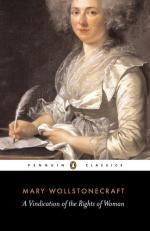
|
| Name: _________________________ | Period: ___________________ |
This test consists of 15 multiple choice questions and 5 short answer questions.
Multiple Choice Questions
1. According to Chapter 6, what has a determinate effect on women's characters?
(a) Early associations and ideas.
(b) Formal education.
(c) Religious upbringing.
(d) Husband.
2. What profession is “incompatible with freedom?”
(a) Royalty.
(b) Any kind of office job.
(c) A standing army.
(d) Beggar.
3. How should education be supplemented?
(a) With society in which people live.
(b) With public debate.
(c) With faith.
(d) With individual study.
4. Who is the first author Wollstonecraft addresses in Chapter 5?
(a) Dr. Gregory.
(b) Jean-Jacques Rousseau.
(c) John Locke.
(d) Jasper Forde.
5. Wollstonecraft hopes that _____________will forgive her.
(a) Her husband.
(b) Men.
(c) Women.
(d) God.
6. Which of the following is NOT a focus of women's education?
(a) Producing silly women.
(b) Trade skills.
(c) Trying to get married.
(d) Perfecting their beauty.
7. Who argues that man is a solitary animal?
(a) Milton.
(b) Dr. Gregory.
(c) Rousseau.
(d) Descartes.
8. What type of people ignores their health in pursuit of their calling?
(a) Religious men and women.
(b) People of genius.
(c) Mothers.
(d) The poor.
9. What does Wollstonecraft say offers a great advantage in forming women's characters?
(a) Acquiring knowledge.
(b) First impressions.
(c) Religious upbringing.
(d) Social interactions.
10. Which women in society have the most virtue, according to Wollstonecraft?
(a) Mothers.
(b) Educated women.
(c) Poor women.
(d) Rich women.
11. How are men improved?
(a) By striving for reason.
(b) By women.
(c) By virtue.
(d) By faith.
12. What does Rousseau say is required of girls for them to be thought beautiful?
(a) They must not be educated.
(b) They must have children.
(c) They must be married.
(d) They must be kept under constant and severe restraint in their bodies and minds.
13. Whose children's books does Wollstonecraft address in Chapter 5?
(a) The Baroness de Stael's.
(b) Madame Genlis's.
(c) Mrs. Piozzi's.
(d) Mrs. Chapone's.
14. What is the title of the work by Dr. Gregory Wollstonecraft that he addresses in Chapter 5?
(a) Legacy to His Daughters.
(b) Raising Women.
(c) On the Education of Daughters.
(d) Emilie.
15. What has reason been mixed with over the course of mankind?
(a) Intuition.
(b) Error.
(c) Prejudice.
(d) Faith.
Short Answer Questions
1. What does Wollstonecraft think of the idea of a coquette as natural?
2. When it comes to relationships between men and women, who will always have the advantage?
3. What gives man preeminence over creatures?
4. Who complains about the silliness of women?
5. Why do women's opinions waver?
|
This section contains 410 words (approx. 2 pages at 300 words per page) |

|




